This was published 2 years ago
The hit TV show shot entirely by amateurs finally arrives in Australia
Take 10 people and a bunch of camera equipment to the wilderness, without food, shelter or supplies. Come back months later and hey presto – it’s Alone.
By Karl Quinn
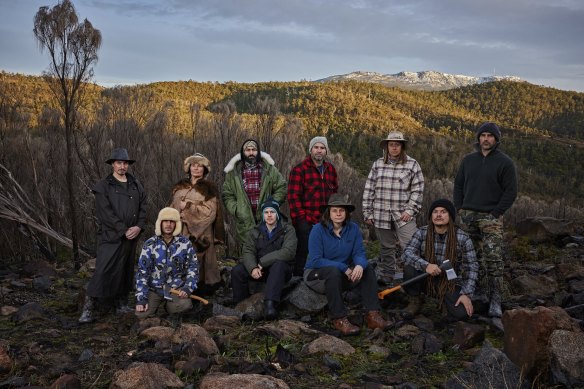
The starting line-up of Alone Australia.Credit: SBS
Having worked on eight seasons of I’m a Celebrity … Get Me Out of Here!, Riima Daher knows all about the challenges of filming in a remote location, where people are forced to sleep rough and to eat the sorts of things they might normally prefer to swat away. But Alone Australia, the first local iteration of the format that has notched up nine seasons in America and three separate Scandinavian versions, was a whole new level of difficult.
“Nothing prepares you for Alone,” says Daher, executive producer of the show that was shot in winter on the shores of a lake in the remote west of Tasmania. “With Celebrity, you’re preparing a bunch of people who know how to make TV to go into a completely unknown scenario, and they’re terrified of that scenario.
“With Alone, you’re taking people who are not afraid of the scenario you’re putting them into – they’re all comfortable in the bush to a certain extent – but they don’t know how to make TV, and you’re turning them into documentary makers.”
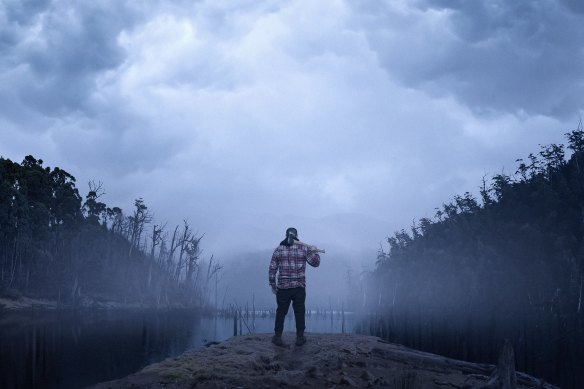
Hunger is a major challenge for the contestants on the show, but so is isolation.Credit: SBS
For the uninitiated, the central premise of Alone is that a bunch of people are dropped into a remote wilderness with minimal supplies, and are left to hunt their own food, build their own shelter, and survive in total isolation for as long as possible. The last person standing wins – in the Australian version, $250,000 (the biggest prize in the US has been $1 million; the Scandis compete purely for the joy of it all).
There are no Survivor-style challenges, no voting, and no crew. The contestants are supplied with multiple cameras and batteries and, after a brief filmmaking boot camp, sent out into the wild to do their own filming.
They can tap out via satellite phone if they’ve had enough or are sick or injured, but they have no contact with the other competitors, or with the outside world.
It is, obviously, an enormous challenge for the contestants (the longest stint to date is the 100 days racked up by the winner of season 7, though many barely make it through the first night). But it’s nerve-racking for the production team too.
In fact, the hardest thing about producing the show, says Daher, is not producing it.
“Normally we’re in charge of the cameras, we’re in charge of the sound, we’re in charge of the cast, we’re in charge of the action. Here, once you’ve dropped them off, you’re flying blind.”
It can be 10 days between footage drops, where the cameras’ SD cards are left in an agreed location for the unit team to collect. And in that time, the producers have no way of knowing what’s going on. Someone may have shot with the lens cap on, or with mud or rain or fog obscuring everything. They may have failed entirely to capture the most dramatic moments amid the endless tedium of walking through forest looking for an edible root or berry.
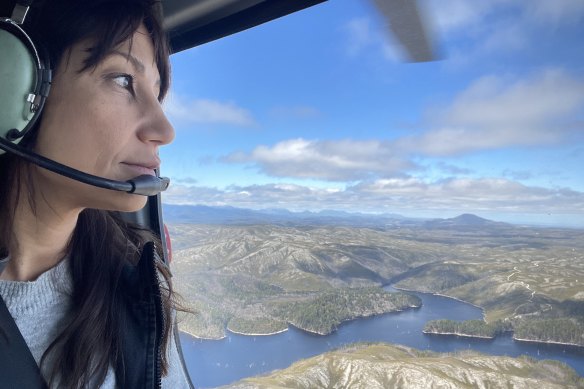
Executive producer Riima Daher flies over the show’s location in western Tasmania. Credit: SBS
“There’s no way of rolling back on the film and doing something again if they didn’t capture it,” says Daher. “It goes against every instinct you have as a producer to make this show because you’re just surrendering complete control to 10 strangers, some of whom are still struggling to work out where the card goes in the camera on day one. We have no visibility whatsoever. That’s terrifying.”
For some of the contestants, the reality of making a home among the gum trees hits hard, and fast. A couple are gone within days, as the scarcity of resources, the bitter cold and the risk of death from a dropping tree limb (deadfall, as it’s known) becomes all too real.
But for Chris Bakon, a Tasmanian and a military veteran, the location about 30 kilometres from Lake St Clair was just one more aspect of the experience to revel in.
“The whole process was really fun, the casting and meeting everyone. And once we got to boot camp, that’s when the experience really started,” the 40-year-old says. “Those days meeting the others and having the education in Indigenous culture, that was just amazing.
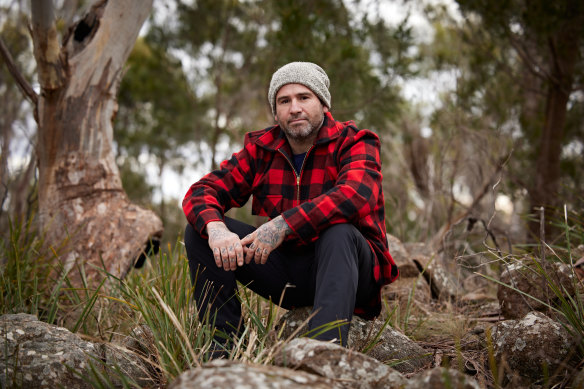
Chris Bakon, one of the 10 contestants in Alone’s first Australian season.Credit: SBS
“When we got dropped in the wilderness, I was like, ‘Man, this has been so good already, now let’s just extend that’. I learnt so much, I had such a good experience. Obviously, like everybody, lots of ups and downs. But overall, it was great.”
Bakon lives alone, which he concedes may have helped him in some respects, because what so often undoes contestants, no matter how well they adapt to their physical circumstances, is the longing to connect with the partners and kids they’ve left behind.
But he has other mental challenges to contend with, the greatest of which is the PTSD he has been living with since leaving the army in the mid-2000s.
“I found it really hard to fit back into society and find my place,” he says of life after a stint in Iraq. “I became a workaholic, and when I wasn’t working, I was just drinking beer and doing everything to stay away from the real world.”
Until his diagnosis with PTSD about four years ago, he says, “I didn’t even know what it was”. Now, “my life revolves around my own mental health recovery and therapy”.
He was upfront about that in his application for the show – he was among the 1000 or so who applied – and feels that neither the producers (ITV) nor the broadcaster (SBS) discriminated in any way, “and that’s a great thing”.
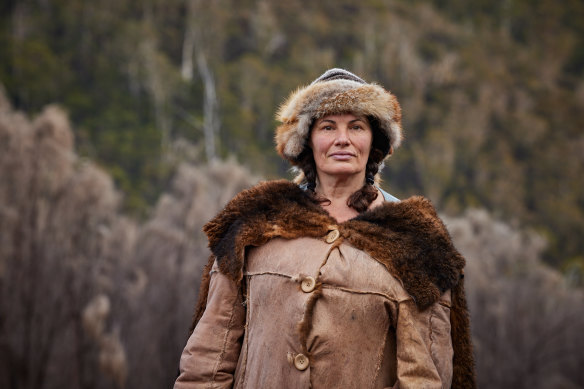
Gina, one of the contestants dropped into western Tasmania for the new series.Credit: SBS
But what about the duty of care aspect – is there a risk that someone with anxiety, say, might be put under intolerable stress out there?
“You can still do amazing things when you’re dealing with all this sort of stuff,” says Bakon. “Also, someone that doesn’t have any of this can still have mental health issues when they go out there.”
Hunger is the single greatest pressure point on Alone, wreaking havoc on both physical and psychological wellbeing. But along with the scarcity of supply on the Australian version, there’s a real limitation on what can be caught. Introduced species such as trout are fine, but many native animals are protected and thus off-limits.
“I was having some really vivid dreams about food out there,” says Bakon. “The realisation that I can’t just go to the fridge was the hardest thing. A big thick-based, oily pepperoni pizza was something that just popped into my head every day.”
He won’t reveal how far he went in the competition – and from the early episodes, you’d bet against him going all the way – but Daher is convinced neither he nor any of the others was primarily motivated by the prize on offer.
“It was never a financial priority for any of them to do this series, they were all genuinely invested in the experiment,” she says.
With one season under her belt, she’s hoping Alone Australia can become an established part of the local television landscape. And she’d love, she adds, to break the cold mould the show has so far followed.
“I would love to be the first territory to do a hot-weather Alone,” she says, flagging the Daintree or Northern Territory as locations that could work well.
“That comes with other dangers like crocs that you can’t mitigate against, so it might never be a possibility,” she adds. “But one can dream.”
You can take it with you
Contestants on Alone are allowed to choose 10 items from a list of survival implements. In addition, they take a small amount of clothing.
Here’s what Chris Bakon had with him.
What Chris Bakon packed
Clothing
- Two pairs of trousers
- Two thermal tops
- Two thermal bottoms
- Four pairs of socks
- Four pairs of undies
- One jumper
- One jacket
- One heavy-duty raincoat
The 10 items
- Sleeping bag
- Bivouac bag
- Tarp
- Multi-tool
- Fold out handsaw
- Axe
- One-litre stainless steel pot with lid
- Fishing line and hooks
- Paracord
- Firestarter (striking flint)
Alone Australia is on SBS from Wednesday March 29 (episode 1 and 2) at 7.30pm.
Find more of the author’s work here. Email him at kquinn@theage.com.au, or follow him on Facebook at karlquinnjournalist and on Twitter @karlkwin.
Find out the next TV, streaming series and movies to add to your must-sees. Get The Watchlist delivered every Thursday.